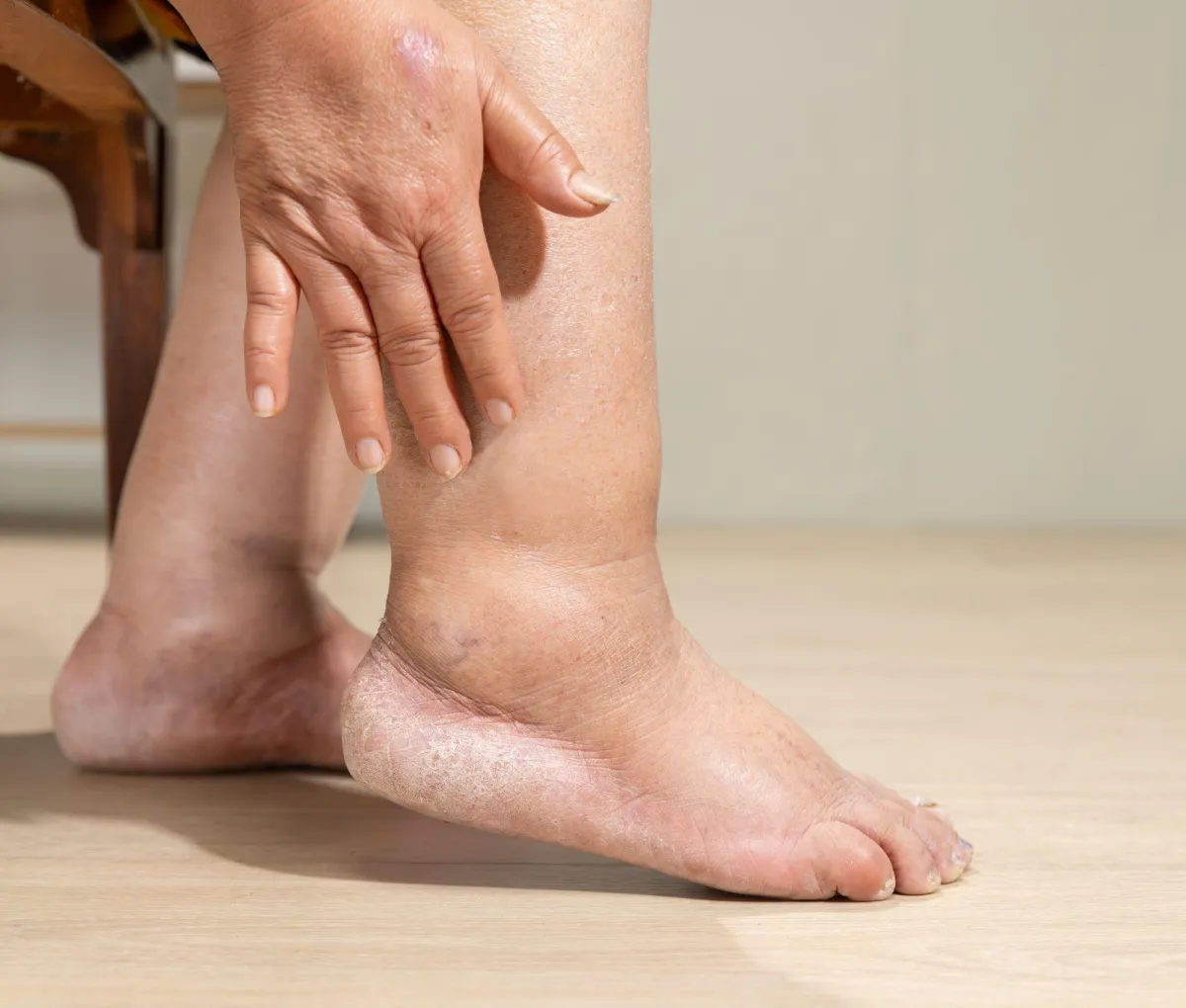
Why Are My Legs Swollen? A Deep Dive Into Causes and Relief
Have you ever looked down at your ankles at the end of a long day and wondered, “Why do my legs look like this?” We certainly have—because we hear this question nearly every day in our Hawthorne showroom.
At MCB DME we’ve been fitting compression garments and educating our neighbors for decades. We’ve seen swelling triggered by everything from a salt‑laden holiday dinner to a heart condition. If you’re reading this, you or someone you love may be concerned about puffy legs and want to know what’s going on.
Let’s talk about it—plainly and compassionately. We’ll walk through the most common causes of leg swelling, explain how to distinguish harmless puffiness from a potential medical issue, and share practical relief strategies.
Throughout this conversation our friendly mascot Lumi 🦉 will pop in with nuggets of wisdom and even direct you to other helpful articles, like our Flat vs. Circular Knit Stockings and our post on Pneumatic Compression Pumps so you can dive deeper as needed.
Understanding Leg Swelling: Not All Swelling Is Created Equal
First, a quick biology lesson—told in simple language. Swelling, or edema, happens when excess fluid gets trapped in your body’s tissues.
Gravity naturally pulls blood and lymphatic fluid toward your feet and ankles; normally, your veins and lymph vessels work like pumps to return it to your heart. When something interrupts that delicate balance, fluid builds up in the soft tissues and makes them swell.
This isn’t always bad—if you spend six hours in the car driving down the Garden State Parkway to visit your sister in Cape May, your ankles may puff up because you didn’t move them for hours. A good night’s rest with your feet elevated and you’re back to normal.
But persistent swelling that doesn’t go away or is accompanied by pain could signal an underlying condition that deserves attention. Vascular & Interventional Specialists note that swelling can range from mild, painless puffiness to severe edema that dramatically alters leg shape.
Once you understand what “normal” looks like for your body, it’s easier to spot when something’s off.
Lumi likes to think of edema like rainwater collecting on a sidewalk: a light sprinkle evaporates quickly, but a clogged drain causes puddles that linger.
In the next sections we’ll unpack eight common reasons why your body’s “drains” might not be working optimally.
Don’t worry if you aren’t a medical professional—our goal is to explain the science in everyday terms so you feel empowered rather than overwhelmed. And if at any point you want to learn more about the garments we recommend, check out our article comparing Flat Knit vs. Circular Knit Compression Garments where we break down fabric structures and when each is appropriate.
Common Causes of Leg Swelling
Let’s explore the most frequent causes one by one. You may recognize your own situation in one cause—or see a combination of several.
While we strive to provide clear information, remember that nothing here replaces a conversation with your healthcare provider. If something feels wrong, trust your intuition and reach out for professional care.
1. Edema and Fluid Retention
Edema simply means fluid trapped in your body’s tissues. It’s often due to benign triggers like high salt intake, prolonged standing or sitting, hot weather, or hormonal changes. When you consume excess sodium, your body retains water to dilute the salt, leading to puffiness.
Dehydration paradoxically prompts your body to hold onto fluid. Even wearing tight clothing can impede circulation and cause temporary swelling. For most people, elevating the legs, reducing salt, and staying hydrated reduces this type of swelling within hours.
However, chronic fluid retention may indicate heart, liver or kidney issues (discussed below).
2. Chronic Venous Insufficiency (CVI)
Our veins rely on one‑way valves to move blood back toward the heart. Chronic venous insufficiency occurs when these valves become weakened or damaged, causing blood to pool in the legs and ankles.
Johns Hopkins Medicine explains that CVI results from valves in the legs not working properly or from a blood clot that blocks normal blood flow.. Symptoms include leg swelling, aching, heaviness, cramping at night, and skin changes or varicose veins. Risk factors include being overweight, pregnancy, history of blood clots, or prolonged standing.
CVI is like a hose with a kink: when valves don’t close properly, blood leaks backward and accumulates. Compression garments and elevating the legs are first‑line treatments, while severe cases may require medical procedures to repair or remove damaged veins.
3. Injuries and Infections
Sprains, strains, fractures or infections can all cause localized swelling. When tissue is injured, your body rushes fluid and immune cells to the area to help heal the damage. This inflammatory response often causes redness, warmth and swelling.
Vascular & Interventional Specialists note that injuries or infections can be triggers for leg swelling. For example, cellulitis (a bacterial skin infection) causes painful swelling, redness, and sometimes fever.
If you have sudden swelling accompanied by pain, redness or heat, see your doctor promptly. Left untreated, infections can spread and become serious.
4. Lymphedema (Lymphatic System Disorders)
The lymphatic system is a network of vessels that drains protein‑rich fluid (lymph) from tissues and returns it to the bloodstream.
Lymphedema occurs when lymph nodes or vessels are damaged or removed (often due to cancer treatments) or when the system is congenitally malformed. The Mayo Clinic notes that lymphedema results from a blockage in the lymphatic system, leading to fluid accumulation in tissues.
Vascular & Interventional Specialists add that lymphatic system issues or lymphedema are a cause of leg swelling. Over time, swelling becomes chronic and can cause thickening of the skin (fibrosis).
It's like a traffic jam: when the lymph “roads” are blocked, fluid backs up in the legs. Treatment includes manual lymph drainage, compression garments, and pneumatic compression pumps (discussed later). Early detection and management are essential to prevent complications.
5. Heart, Liver and Kidney Conditions
Organ systems can also contribute to swelling. Congestive heart failure causes the heart to pump less efficiently, leading to fluid buildup in the legs. Liver disease (cirrhosis) alters fluid regulation and protein production, causing swelling in the abdomen and legs.
Kidney disease impairs the body’s ability to excrete sodium and fluid, leading to widespread edema. Vascular & Interventional Specialists highlight that heart, liver and kidney conditions can cause swollen legs.
If you have existing heart or kidney disease and notice increased swelling, contact your physician. Lumi reminds us that these conditions require medical management to control fluid balance and protect vital organs.
6. Medication Side Effects
Several medications can cause fluid retention, including some blood pressure drugs, diabetes medications, steroids and hormone therapies. Because everyone’s body reacts differently, it’s important to discuss side effects with your doctor or pharmacist.
Never stop a medication abruptly without medical guidance. If you suspect medication‑related swelling, ask your prescriber about alternatives.
7. Pregnancy
During pregnancy, the body produces more blood and fluids to support the growing baby. Additionally, the uterus puts pressure on veins in the pelvis, slowing blood return to the heart. Mild swelling in the feet and ankles is normal.
However, sudden swelling in the face or hands can signal a serious condition called preeclampsia and should prompt immediate medical attention. Wearing compression stockings, elevating the legs and staying active can ease discomfort.
8. Other Causes
Other less common causes include thyroid disorders (hypothyroidism can cause myxedema), blood clots (deep vein thrombosis), and certain autoimmune diseases. Because swelling is a nonspecific symptom, comprehensive evaluation is essential for persistent or worsening cases.
MCBDME encourages you to keep a symptom journal noting when swelling occurs, what you ate, and your activity level; this information can help your healthcare provider identify patterns.
When to See a Doctor
Most minor swelling resolves with rest, elevation and hydration. However, there are times when you should seek medical attention immediately.
Vascular & Interventional Specialists advise seeing a doctor if swelling is sudden or severe, occurs in one leg only, is accompanied by pain or redness, or if you have difficulty breathing. Other red flags include leg ulcers, skin discoloration, or new varicose veins—possible signs of venous insufficiency.
If you have a known heart, liver or kidney condition and notice increasing swelling, contact your provider promptly.
Practical Tips to Reduce Swelling and Improve Comfort
Elevate Your Legs. Rest with your legs above heart level for 15–30 minutes several times a day. Gravity helps fluid return toward the torso.
Stay Active. Gentle movement like walking, ankle pumps and calf stretches keeps blood and lymph flowing. Avoid standing or sitting for long periods.
Wear Compression Garments. Graduated compression stockings or sleeves support your veins and lymphatic vessels. Choose the correct size and compression level (see our second post for measuring instructions). Medi vs. Juzo vs. Jobst compression brands have pros and cons; you’ll find a comparison on our blog.
Manage Salt and Hydration. Reduce sodium intake and drink plenty of water. Herbal teas like dandelion or ginger may help, but discuss with your doctor if you have kidney or liver disease.
Skin Care. Keep skin moisturized to prevent dryness or cracking. Clean any cuts promptly to avoid infection.
Monitor Weight. Sudden weight gain can indicate fluid retention from heart or kidney problems. Weigh yourself daily and report significant changes to your physician.
Consider Pneumatic Compression Pumps. For lymphedema or severe venous insufficiency, at‑home pneumatic pumps provide sequential pressure to move fluid (see our third post).
Your Local New Jersey DME Partner
MCB DME is proud to be New Jersey’s #1 DME solution. We partner closely with physicians, physical therapists and lymphedema specialists to provide top‑quality compression garments and pumps. Our knowledgeable team offers one‑on‑one fittings and personalized education.
Because we’re local, we provide fast service and compassionate support—no need to order from out‑of‑state or navigate confusing online platforms. Our Hawthorne location is convenient for patients throughout northern New Jersey, including Passaic, Bergen and Essex counties.
If your legs are swollen and you’re wondering what to do next, we invite you to reach out. Visit our contact page to schedule a consultation, ask Lumi a question, or simply share your story.
We’ll listen, guide you to the right resources and products, and support you every step of the way. You deserve to feel comfortable and confident—and we’re here to help.
